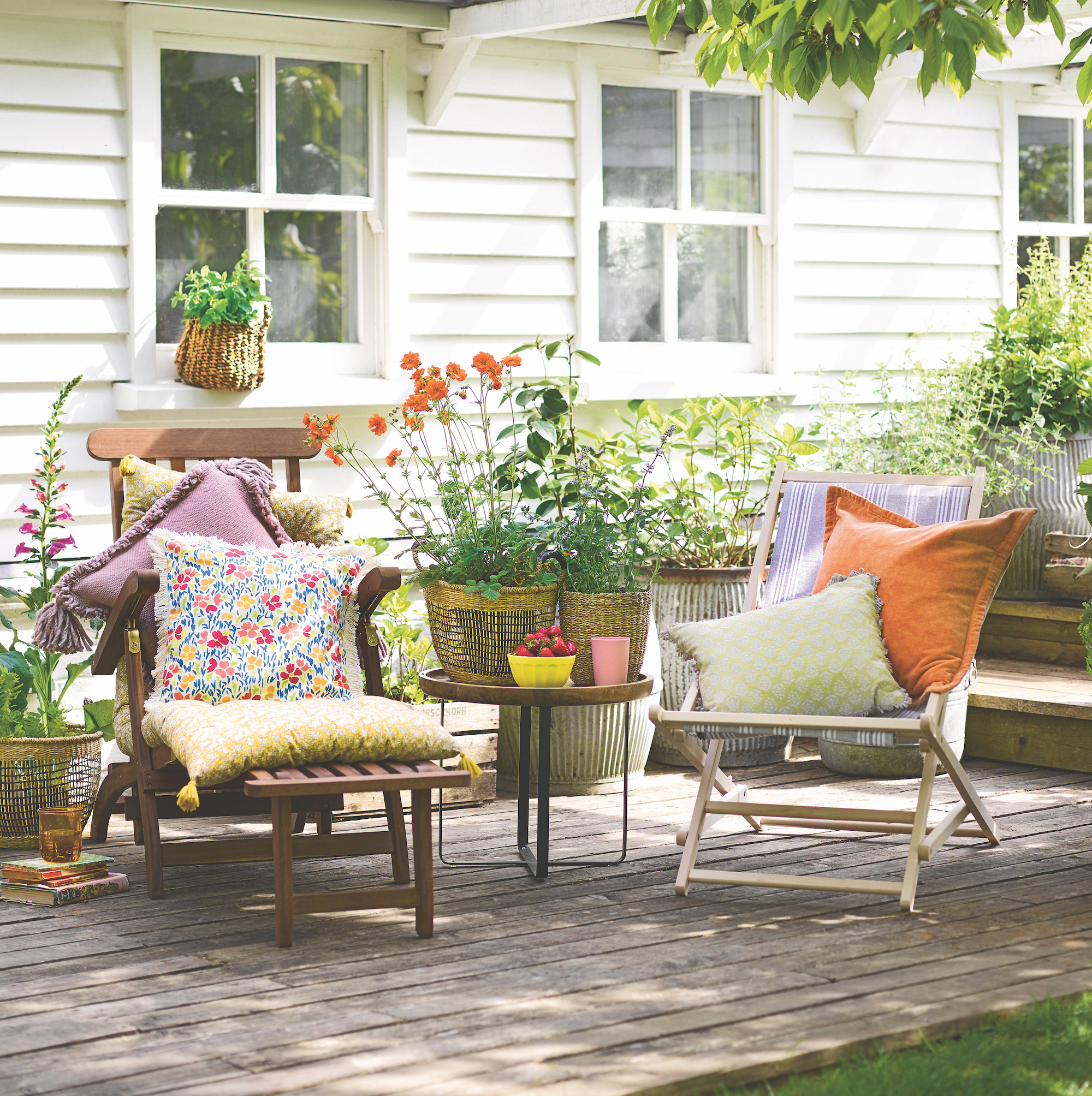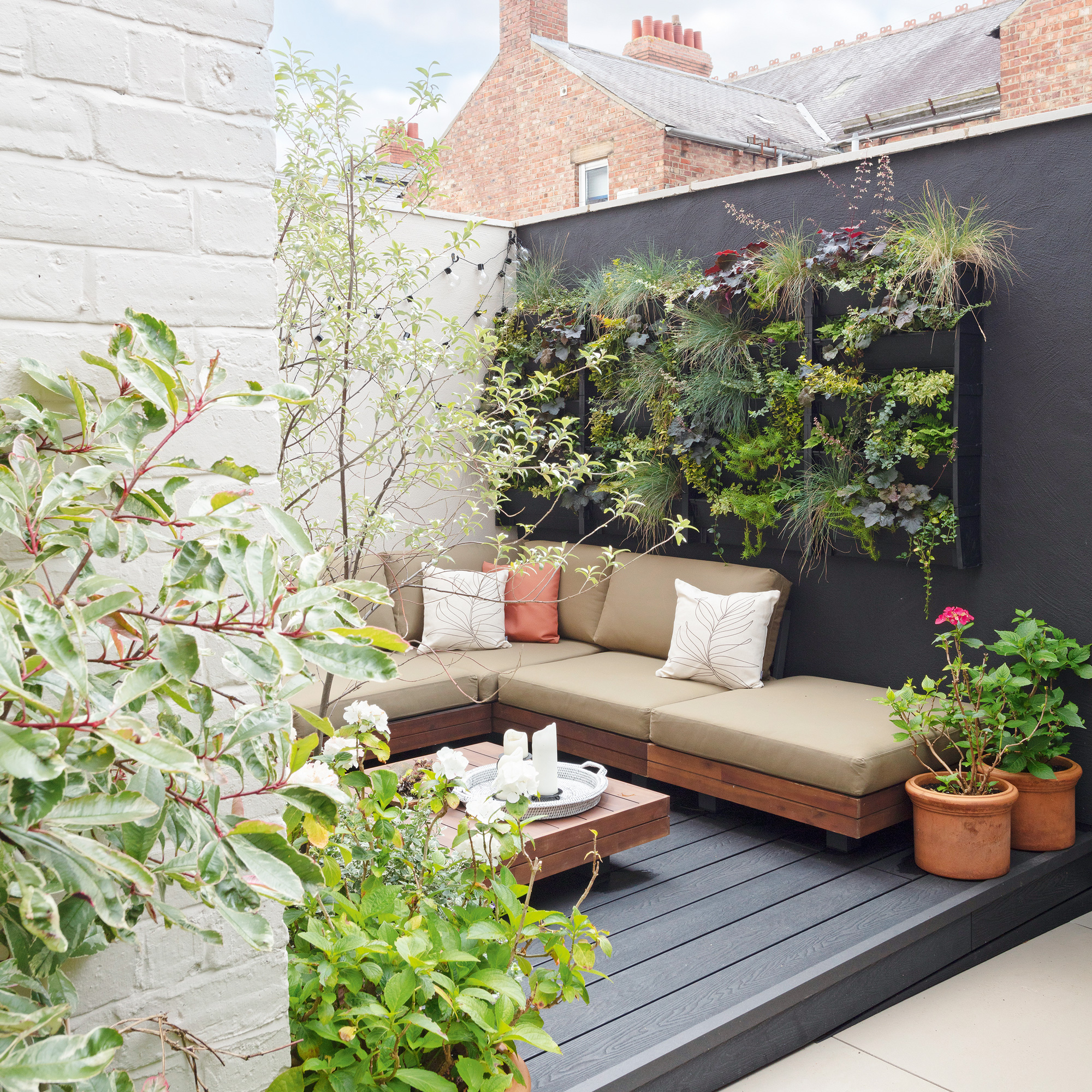Should you pressure wash decking? Experts warn it could be a costly mistake
Why you might want to choose a different cleaning method this summer


Your decking area experiences the full brunt of the English weather, from torrential downpours to violent winter storms. But if you’re looking to clean your decking this summer summer, you might wonder: Can you pressure wash decking?
Yes, you could have the best garden decking idea out there, but nothing will protect your deck from the build-up of algae, lichen, moss - and even the odd tomato sauce stain. That’s why you should keep on top of cleaning your decking and add this task to your to-do list at least once a year.
And while you could get on your hands and knees and scrub at your decking for hours on end, there’s no doubt that using one of the best pressure washers seems like it would be a lot easier. But can you safely use this handy garden gadget to clean your decking? Well, it’s not a simple answer.
Should you pressure wash decking?

In theory, you can pressure wash anything you put your mind to. All you have to do is turn it on and get the party started. But just because you can pressure wash decking doesn’t necessarily mean that you should.
In fact, one of the biggest decking mistakes you could make is not cleaning it properly - and using a pressure washer on wood decking could have potentially disastrous (and costly) ramifications.
‘Excessive pressure can splinter wood and create permanent damage, and you should be particularly cautious with soft woods like cedar and pine, as they are more susceptible to damage from pressure washing,' warns Richard King from Dino Decking.
The same can be said if you have composite decking, but the rules are a little different if you have aluminium decking - an option which is becoming more and more popular.
Sign up to our newsletter for style inspiration, real homes, project and garden advice and shopping know-how
‘When comparing pressure-washing wood decking to aluminium decking, it's important to note that aluminium is more resilient to pressure washing due to its durability and resistance to corrosion,' explains Murray Michel, gardening maintenance and decking expert at Clear Amber.
‘For aluminium decking, you can typically use higher pressure settings and more aggressive cleaning techniques without significant risk of damage,’ he adds.

So, ultimately, it’s down to you (and the type of decking you have) whether you pressure wash your decking or not. And just as you can clean a patio without using a pressure washer, there are also many ways to clean decking without a pressure washer. Especially if you want to prepare your decking for winter.
‘If you don’t have a pressure washer or prefer not to take the risk, there is an alternative way to clean your deck,' advises Beth Boulton, marketing director at Eurocell.
'For a gentler approach, use a simple mixture of dishwashing soap and water with a stiff-bristle deck brush. Lightly scrub away all the dirt on the deck, rinse thoroughly, and allow the deck to fully air-dry.’
Alternatively, if you take precautions, you could still use a pressure washer to wash decking.
How to pressure wash a deck without damaging it
While pressing washing decking can be dangerous, that doesn’t mean that you have to avoid it altogether. You just need to make sure that you do it safely - and here are 8 expert-approved tips to pressure wash your decking without damaging it:
What you'll need
Step-by-step

1. Inspect for damage
While you might assume that everyone can pressure wash their decking if they take precautions, that isn’t the case.
‘First, you need to inspect your garden for any signs of damage from the winter and the various storms your garden endured over winter,' advises Jimmy Englezos, senior brand manager from Ronseal.
‘Key signs of wood damage include spots of darkened wood, a cracked appearance that may even crumble when you touch it, as well as visible fungus.’
If your decking is damaged, you should avoid pressure washing it. Instead, focus on fixing it. And if the damage is too severe, you may want to check out our guide on how to lay decking to replace it completely.
2. Brush away any loose debris
As pressure washing can damage your decking, you want to keep the cleaning to a minimum - especially as pressure washers use a lot of water. So, you can start by brushing away any loose debris with a broom.
This first brush should be enough to remove leaves, crumbs, and any large chunks of moss that have accumulated over the past few months.
3. Use a cleaning agent
While you can simply use the water in the pressure washer to clean your decking, using a cleaning agent will not only speed up the process - but will also be more effective. In most cases, you can use one of the best patio cleaners for this process.
However, you should avoid anything with bleach in it, no matter whether you have wooden or composite decking.
‘Contrary to belief, household bleach should never be used to clean decking,' warns Jimmy. 'This is because the bleach corrodes the metal fasteners, screws, and nails causing them to rust at first and then weaken. Bleach can also damage the surface of composite decking, causing it to discolour and possibly chip.’

So, use a specific decking cleaner or make your own using natural cleaning products. Jimmy even suggests using a mixture of bicarbonate of soda and vinegar to clean your decking.
‘Simply sprinkle some bicarbonate of soda across the decking surface before mixing one cup of vinegar into a bucket of warm, but not boiling, water. Dip the bristles of a soft-touch brush into the solution and gently scrub the decking surface.’
‘The bicarbonate of soda will react with the diluted vinegar to help remove any stains, mildew, and mould. Make sure to thoroughly rinse the decking afterwards using a pressure washer or garden hose.’
4. Use a low-pressure setting
The main reason people choose to use a pressure washer over a normal garden hose is because of the high-pressure settings, but it’s this high pressure that could potentially damage your decking.
Because of this, aim to use a low-pressure setting on your pressure washer when you want to clean your decking. ‘Using too high a pressure setting can gouge and damage your deck's surface,' warns Richard.
‘For wood decks, keep the pressure between 500 to 600 PSI to prevent any harm. For composite decks, the pressure setting should be no higher than 1,500 PSI.’
If in doubt, always test a small area of your decking before cleaning the whole thing.

5. Use the correct attachments
If you have one of the best pressure washers at your disposal, you’ll likely have a whole selection of nozzles and attachments to use for different tasks.
And if you want to pressure wash decking without damaging it, it’s best to use either the fan nozzle or rotary attachments. Richard is particulalty fond of the fan tip nozzle.
‘A fan tip nozzle with a 40 to 60-degree spread is ideal for deck cleaning. This wider spread reduces the pressure on any one spot and provides an even clean.’
When using your pressure washer, you should also aim to keep the nozzle around 15cm away from the surface to prevent any damage.
6. Clean in the direction of the grain
Knowing how to use a pressure washer is key when cleaning your decking area. When cleaning wooden or composite decking, you should always clean in the direction of the grain.
This will reduce the strain and the pressure on the decking, which will ultimately reduce the possibility of damage. Not only that, but it will also allow for a more natural finish, and the grain will offer you a guide to use when cleaning.
‘A top tip for pressure washing efficiently is to always work in the direction of the wood grain to minimise the risk of splintering,' agrees Murray. 'Maintain a consistent and even movement with the pressure washer nozzle, avoiding prolonged exposure to any single spot, which could cause unintended damage.’

7. Brush away excess water
When you’ve finished pressure washing your decking and you’re happy with the results, you should then grab your broom and brush away any excess water or puddles.
This will prevent the water from seeping into the wooden decking and rotting it from the inside, and will also make your garden safer for those walking over your decking.
When the larger puddles have been brushed away, you can let your decking air dry.
8. Treat your decking
There’s nothing better than seeing a clean decking area, but if you want to keep it that way, you should finish by treating your wooden decking. This will not only protect it after the stress of pressure washing but also prevent any future build-up of algae or dirt.
While we’d suggest using this Ronseal Garden Clear Matt Decking Protector from B&Q, what you use is ultimately up to you.
You could even use this chance to paint or stain your decking a different colour. Just make sure that the product you use offers some kind of protection from the elements. You shouldn’t need to do this with composite decking, however.
Just make sure you apply this at the right time. ‘Allow the decking to dry completely before applying any sealant or stain,' advises Richard. 'This ensures the best adherence of protective coatings.’

FAQs
What is the best thing to clean decking with?
A deck-specific cleaning agent will help you clean your decking area, as it’s been specially designed to deal with the material and the build-up of algae and moss that can affect decked areas.
However, you don’t always have to buy a specific cleaner. You could also use water and washing-up liquid or a mixture of white vinegar and bicarbonate of soda (baking soda). Whatever you do, you should never use bleach when cleaning your decking.
How do I get algae off my deck without a pressure washer?
If you don’t have a pressure washer, you can still clean your deck. All you need is a stiff-bristled broom and a bucket of soapy water. Then, you can simply brush away the algae and other dirt off your deck. Finish by rinsing with clean water - either from a clean bucket or a garden hose.
Although you can use a handheld brush for this process, it’s a lot easier if you use a clean broom, as this will put less pressure on your knees and back.
So, you can indeed pressure wash decking… but you need to be careful.

Lauren Bradbury has been the Content Editor for the House Manual section since January 2025 but worked with the team as a freelancer for a year and a half before that. She graduated with a Bachelor’s degree in English and Creative Writing from the University of Chichester in 2016. Then, she dipped her toe into the world of content writing, primarily focusing on home content. After years of agency work, she decided to take the plunge and become a full-time freelancer for online publications, including Real Homes and Ideal Home, before taking on this permanent role. Now, she spends her days searching for the best decluttering and cleaning hacks and creating handy how-to guides for homeowners and renters alike, as well as testing vacuums as part of her role as the Ideal Home Certified Expert in Training on Vacuums, having spent over 110 hours testing different vacuum models to date!


